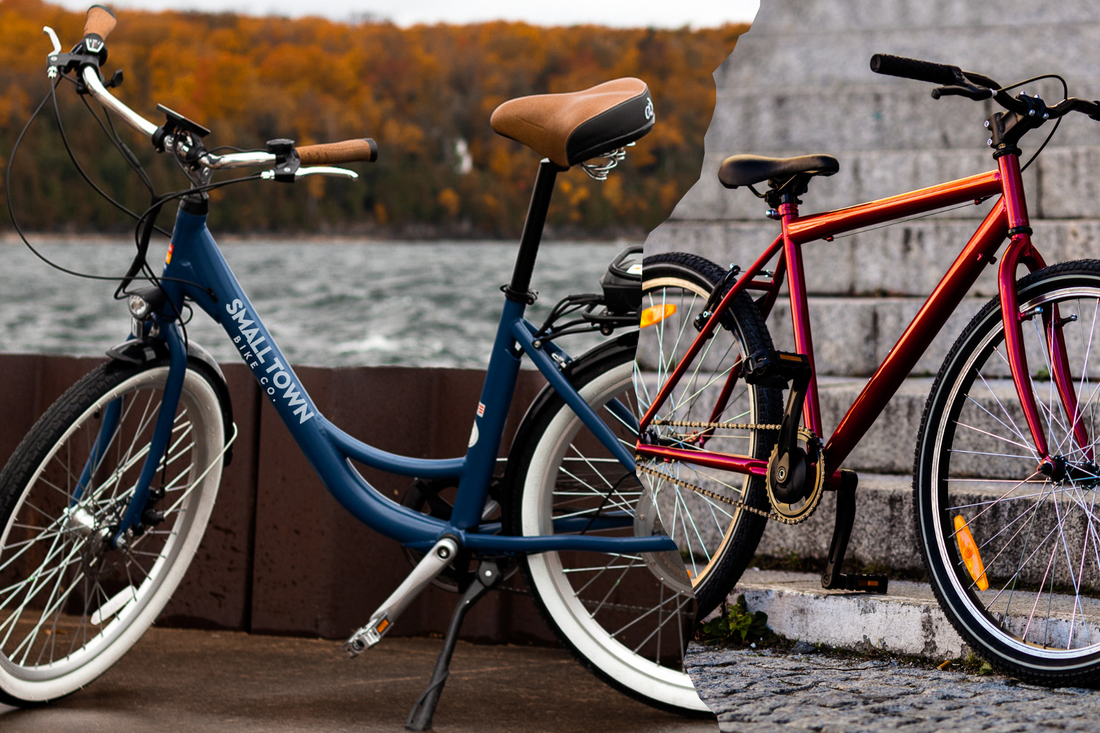Choosing between an electric bike and a hybrid bike can be confusing. Both options offer unique features and benefits.
Electric bikes, or e-bikes, come with a motor that assists with pedaling. They provide a boost, making rides easier and faster. Hybrid bikes, on the other hand, combine features from road and mountain bikes. They are versatile and suitable for various terrains.
Understanding the differences can help you make an informed decision. This blog will explore the key distinctions between electric and hybrid bikes. We’ll discuss their advantages, uses, and which might be the best fit for your needs. Whether you’re commuting, exercising, or exploring, knowing these differences will guide you in choosing the right bike.
Table of Contents
Key Components
Electric and hybrid bikes are popular options for commuting and leisure. Understanding their key components helps in making an informed choice. Let’s explore the main elements that set them apart.
Battery And Motor
The battery and motor are crucial for both electric and hybrid bikes. An electric bike typically has a larger battery capacity. This allows for longer rides without pedaling. The motor in an electric bike is usually more powerful. It provides a smooth and fast ride. Hybrid bikes, on the other hand, have smaller batteries. Their motors are less powerful. They are designed for mixed use, combining pedaling with motor assistance.
Pedal Assist And Throttle
Pedal assist and throttle are two key features in electric and hybrid bikes. Electric bikes often come with both options. Pedal assist gives you a boost while pedaling. The throttle allows you to ride without pedaling. Hybrid bikes usually focus on pedal assist. They encourage more pedaling. This makes them ideal for fitness enthusiasts. Understanding these components helps you choose the right bike for your needs.
Performance
When choosing between an electric bike and a hybrid bike, performance plays a crucial role. Performance encompasses how well the bike operates in various conditions and how it meets the rider’s needs. Understanding the differences in performance can help you make an informed decision. Let’s explore the key aspects of performance: speed, range, and terrain capabilities.
Speed And Range
Electric bikes often feature powerful motors. These motors can boost speeds up to 28 mph. Typically, electric bikes have a range of 20 to 50 miles per charge. The range depends on factors like battery size, rider weight, and terrain.
Hybrid bikes combine pedal power with electric assistance. They usually reach lower top speeds compared to electric bikes. Most hybrid bikes offer a range of 30 to 60 miles. Their range varies based on the same factors as electric bikes.
Terrain Capabilities
Electric bikes excel on flat and paved surfaces. They handle city streets and smooth paths with ease. The powerful motors can tackle slight inclines without much effort.
Hybrid bikes are versatile. They perform well on various terrains, including light trails and gravel paths. Their design supports both on-road and off-road adventures. With a hybrid bike, you get the flexibility to explore different landscapes.
Environmental Impact
Electric bikes and hybrid bikes offer unique benefits for the environment. They both reduce dependency on fossil fuels and help decrease pollution. But, there are differences in their environmental impacts that are worth noting.
Carbon Emissions
Electric bikes produce zero direct carbon emissions. They run on battery power and do not burn fuel. This makes them a clean alternative to traditional vehicles.
Hybrid bikes, on the other hand, combine human pedaling with electric power. They still generate some emissions. Yet, they are lower compared to cars or motorcycles.
Energy Consumption
Electric bikes use electricity to charge their batteries. The source of this electricity affects their total energy footprint. If charged with renewable energy, the impact is minimal.
Hybrid bikes require less energy overall. They rely more on human power. This reduces the amount of electricity needed. Thus, they tend to have a smaller energy footprint.
| Factor | Electric Bike | Hybrid Bike |
|---|---|---|
| Carbon Emissions | Zero direct emissions | Low emissions |
| Energy Consumption | Depends on electricity source | Lower overall energy use |
Both electric and hybrid bikes are better for the environment compared to cars. They offer a greener way to travel, with unique advantages in their energy use and emissions.
Cost Analysis
Understanding the cost differences between electric bikes and hybrid bikes is essential. Let’s break down the costs into two main categories: initial investment and maintenance expenses.
Initial Investment
The initial cost of an electric bike is generally higher than a hybrid bike. Here’s a basic comparison:
| Bike Type | Price Range (USD) |
|---|---|
| Electric Bike | $1,000 – $5,000 |
| Hybrid Bike | $300 – $2,000 |
Electric bikes often come with advanced features. These include motors, batteries, and sensors. These features increase the initial cost. Hybrid bikes are simpler. They do not need expensive technology. This makes them more affordable.
Maintenance Expenses
Maintenance costs can vary between electric and hybrid bikes. Let’s look at a few key points:
- Electric Bike
- Battery replacement every 2-4 years can cost $300-$500.
- Motor repairs can be expensive. Costs range from $100-$300.
- Regular tune-ups might cost $50-$100.
- Hybrid Bike
- Lower maintenance costs overall.
- Regular tune-ups cost $50-$75.
- Parts like tires and chains are cheaper to replace.
Electric bikes need more specialized care. This can mean higher costs. Hybrid bikes use standard bike parts. This makes repairs and maintenance cheaper.
Considering these factors, both bike types have their own cost implications. Choose based on your budget and needs.
User Experience
Choosing between an electric bike and a hybrid bike can be challenging. User experience is a key factor. This section will focus on Comfort and Ergonomics and Ease of Use to help you decide.
Comfort And Ergonomics
Comfort is essential for long rides. Electric bikes offer a smooth ride due to their motor assistance. The motor reduces strain, making rides less tiring. This helps for longer trips or hilly areas.
Hybrid bikes combine features of road and mountain bikes. They provide a balanced ride. The upright riding position reduces back strain. Hybrid bikes often come with padded seats and wider tires. This adds to the comfort, especially on rough roads.
| Feature | Electric Bike | Hybrid Bike |
|---|---|---|
| Smooth Ride | Motor assistance | Wider tires |
| Long Rides | Less tiring | Balanced comfort |
| Back Strain | Reduced | Reduced |
Ease Of Use
Electric bikes are user-friendly. They have a simple start system. Just turn on the motor and pedal. The motor helps with speed and effort. This makes it easy for beginners.
Hybrid bikes are also easy to use. They require no special skills. Just hop on and ride. Their design suits both city streets and country paths. This versatility makes them popular.
- Electric bikes: Simple start system, motor assistance
- Hybrid bikes: No special skills needed, versatile
Both types of bikes offer unique benefits. Consider your needs and preferences. This will help you choose the right bike for your user experience.

Credit: www.sixthreezero.com
Practical Applications
Both electric bikes and hybrid bikes offer great benefits. They serve various practical applications in daily life. Understanding these uses can help you choose the right bike.
Commuting
Electric bikes are ideal for daily commuting. They provide speed and efficiency. You can cover long distances with ease. The electric motor helps you navigate through traffic. You arrive at work without breaking a sweat. This makes electric bikes perfect for urban settings.
Hybrid bikes, on the other hand, combine features of both road and mountain bikes. They offer versatility. While not as fast as electric bikes, they are still efficient. You get a good workout while commuting. Hybrid bikes are great for short to medium distances.
Recreational Use
For recreational use, both electric and hybrid bikes shine. Electric bikes offer a relaxed and enjoyable ride. They are perfect for long rides on weekends. The motor allows you to explore new places. You can ride uphill or on rough terrain with ease.
Hybrid bikes are excellent for recreational activities too. They provide a balanced mix of comfort and performance. You can ride on various surfaces, from paved roads to light trails. Hybrid bikes are great for fitness enthusiasts. They help you stay active while enjoying nature.
| Bike Type | Best For | Key Features |
|---|---|---|
| Electric Bike | Commuting | Speed, Efficiency, No Sweat |
| Hybrid Bike | Commuting | Versatility, Workout, Short to Medium Distances |
| Electric Bike | Recreational Use | Relaxed Ride, Long Distances, Easy Navigation |
| Hybrid Bike | Recreational Use | Comfort, Performance, Various Surfaces |
Choosing between an electric bike and a hybrid bike depends on your needs. Each type has its strengths. Consider your daily activities and preferences before making a decision.
Pros And Cons
Choosing between an electric bike and a hybrid bike can be tough. Each type has its own set of advantages and disadvantages. Understanding these can help you make an informed decision. Let’s discover the pros and cons of both electric and hybrid bikes.
Electric Bike Advantages
Electric bikes offer a boost to your pedaling power. This makes uphill climbs easier. Commuting long distances becomes less tiring. They are ideal for people who want to reduce physical strain. E-bikes often come with various assist levels. This allows you to choose how much help you need. Additionally, electric bikes are generally faster. You can reach your destination quicker. They are a great option for urban commuting. They help you avoid traffic and save time.
Hybrid Bike Advantages
Hybrid bikes provide a balance between road and mountain bikes. They are versatile and can handle different terrains. Ideal for both city streets and light trails. Hybrid bikes are often lighter than electric bikes. This makes them easier to carry and store. They require less maintenance. Without an electric motor, there are fewer parts to worry about. Hybrid bikes are also generally cheaper. They offer a budget-friendly option for many riders. You get a good workout while riding. Pedaling without motor assistance can improve your fitness.

Credit: www.smalltownbikeco.com
Frequently Asked Questions
What Is An Electric Bike?
An electric bike, or e-bike, is a bicycle with an integrated electric motor. It assists with propulsion, making pedaling easier. E-bikes are perfect for commuting and leisure rides.
How Does A Hybrid Bike Work?
A hybrid bike combines features of road and mountain bikes. It offers versatility, comfort, and efficiency. Hybrid bikes are suitable for various terrains, from city streets to light trails.
Are Electric Bikes Faster Than Hybrid Bikes?
Yes, electric bikes can be faster due to the motor assistance. However, the speed depends on the motor’s power and local regulations. Riders can easily maintain higher speeds with less effort.
Do Hybrid Bikes Need Charging?
No, hybrid bikes do not need charging. They rely on human power for propulsion. Unlike electric bikes, hybrid bikes don’t have a motor or battery.
Conclusion
Choosing between an electric and hybrid bike depends on your needs. Electric bikes offer full motor assistance, ideal for effortless rides. Hybrid bikes combine motor power and pedaling, perfect for fitness enthusiasts. Both bikes are eco-friendly and cost-effective in the long run.
Consider your commuting distance and terrain. Try both options if possible. Find what suits your lifestyle best. Enjoy the ride!

